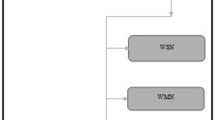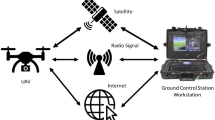Abstract
Flying ad hoc networks (FANETs) consist of unmanned aerial vehicles (UAVs) with energy limitations which have the capability of sending recorded live video stream to supervise their surroundings completely and intelligently. Although significant efforts have been made by previous researchers to increase the quality of received video stream as a main mission of a UAV, challenges like energy consumption, effective use of bandwidth, effective clustering among UAVs and their intelligent communication with ground stations especially at the same time have not been noticed in the past research studies simultaneously. Therefore, in the proposed method, for the first time, a low complex AHP-TOPSIS hybrid algorithm has been used for effective clustering in FANETs. Cluster heads (CHs), in addition to imaging, receive the recorded videos frames by other UAVs through Wi-Fi and send them to the ground station through 5G connection. Using AHP-TOPSIS algorithm, the ground controller intelligently specifies which UAVs should be CH in regular intervals. Therefore, because of UAVs’ swarm reduction and, at the same time, effective use of bandwidth, traffic and delay in transferring live video frames are reduced which leads to achieving high video quality in ground station and, at the same time, reduction UAV energy consumption. The results of numerous simulations in OMNET + + under different conditions show that the parameters of video quality percentage, UAV average energy consumption and the number of necessary cluster head have been significantly improved when two famous mobility models including Paparazzi and Random Waypoint are considered comparing other methods.






















Similar content being viewed by others
References
Nayyar A (2018) Flying Adhoc Network (FANETs): Simulation based performance comparison of routing protocols: AODV, DSDV, DSR, OLSR, AOMDV and HWMP. In: 2018 International conference on artificial intelligence, big data, computing and data communication systems (icABCD), pp 1–9
Sang Q, Wu H, Xing L, Xie P (2020) Review and comparison of emerging routing protocols in flying ad hoc networks. Symmetry Basel 12(6):1–24
Luo C, Miao W, Ullah H, McClean S, Parr G, Min G (2018) Unmanned aerial vehicles for disaster management. In: Durrani T, Wang W, Forbes S (eds) Geological disaster monitoring based on sensor networks. Springer natural hazards. Springer, Singapore. https://doi.org/10.1007/978-981-13-0992-2_7
Rahnamaei Yahiabadi S (2019) Barekatain B and Raahemifar K (2019) TIHOO: An enhanced hybrid routing protocol in vehicular Ad-hoc networks. Eurasip J Wirel Commun Netw 1:1–19
Dehghani S, Pourzaferani M, Barekatain B (2015) Comparison on energy-efficient cluster based routing algorithms in wireless sensor network. Procedia-Procedia Comput Sci 72:535–542
Barekatain B, Maarof MA, Quintana AA and Ghaeini HR (2013) Performance evaluation of routing protocols in live video streaming over wireless mesh networks. Jurnal Teknologi 62(1):85–94
Sahingoz OK (2014) Networking models in flying Ad-hoc networks (FANETs): Concepts and challenges. J Intell Robot Syst Theory Appl 74(1–2):513–527
Shumeye Lakew D, Sa’ad U, Dao NN, Na W, Cho S (2020) Routing in flying Ad Hoc networks: a comprehensive survey. IEEE Commun Surv Tutorials 22(2):1071–1120
Iyer A, Rosenberg C, Karnik A (2009) What is the right model for wireless channel interference? IEEE Trans Wirel Commun 8(5):2662–2671
Andre T et al (2014) Application-driven design of aerial communication networks. IEEE Commun Mag 52(5):129–137
Cruz E (2018) A comprehensive survey in towards to future FANETs. IEEE Lat Am Trans 16(3):876–884
Ladosz P, Oh H, Chen WH (2016) “Optimal positioning of communication relay unmanned aerial vehicles in urban environments”. In 2016 Int Conf Unmanned Aircr Syst ICUAS 2016: 1140–1147
Qi F, Zhu X, Mang G, Kadoch M, Li W (2019) UAV network and IoT in the sky for future smart cities. IEEE Netw 33(2):96–101
Arafat MY, Moh S (2019) A survey on cluster-based routing protocols for unmanned aerial vehicle networks. IEEE Access 7:498–516
Aadil F, Raza A, Khan MF, Maqsood M, Mehmood I, Rho S (2018) Energy aware cluster-based routing in flying ad-hoc networks. Sensors (Switzerland) 18(5):1–16
Khan A, Aftab F, Zhang Z (2019) BICSF: Bio-inspired clustering scheme for FANETs. IEEE Access 7:31446–31456
Arafat MY, Moh S (2019) Localization and clustering based on swarm intelligence in UAV networks for emergency communications. IEEE Internet Things J 6(5):8958–8976
Khan A, Aftab F, Zhang Z (2019) Self-organization based clustering scheme for FANETs using glowworm swarm optimization. Phys Commun 36:100769
Bahri N, Belhadj N, Grandpierre T, Ben Ayed MA, Masmoudi N, Akil M (2016) Real-time H264/AVC encoder based on enhanced frame level parallelism for smart multicore DSP camera. J Real-Time Image Process 12(4):791–812
Ider M, Barekatain B (2020) An enhanced AHP–TOPSIS-based load balancing algorithm for switch migration in software-defined networks. Springer, US
Mohammed MA et al (2020) Benchmarking methodology for selection of optimal COVID-19 diagnostic model based on entropy and TOPSIS methods. IEEE Access 8:99115–99131
Shi W, Zhou H, Li J, Xu W, Zhang N, Shen X (2018) Drone assisted vehicular networks: Architecture, challenges and opportunities. IEEE Netw 32(3):130–137
Bani M, Alhuda N (2016) Flying Ad-Hoc Networks: Routing protocols, mobility models, issues. Int J Adv Comput Sci Appl 7(6):162–168
Jarrah MI et al (2020) A novel explanatory hybrid artificial bee colony algorithm for numerical function optimization. J Supercomput 76(12):9330–9354
Ab Rahman R, Ahmad S and Hashim UR (2019) A study on gamification for higher education students’ engagement towards education 4.0. In: Piuri V, Balas V, Borah S, Syed Ahmad S (eds) Intelligent and interactive computing. Lecture notes in networks and systems, vol 67. Springer, Singapore. https://doi.org/10.1007/978-981-13-6031-2_5
Maistrenko VA, Alexey LV and Danil VA (2016) Experimental estimate of using the ant colony optimization algorithm to solve the routing problem in FANET. In: 2016 International Siberian conference on control and communications (SIBCON), Moscow, Russia, pp 1–10. https://doi.org/10.1109/SIBCON.2016.7491805
Sánchez-García J, Reina DG, Toral SL (2019) A distributed PSO-based exploration algorithm for a UAV network assisting a disaster scenario. Futur Gener Comput Syst 90:129–148
Kaipa KN, Ghose D (2017) Glowworm swarm optimization: theory, algorithms, and applications. Stud Comput Intell 698:265
Zang C, Zang S (2011) Mobility prediction clustering algorithm for UAV networking. In: 2011 IEEE GLOBECOM workshops (GC Wkshps), Houston, TX, USA, pp 1158–1161. https://doi.org/10.1109/GLOCOMW.2011.6162360
Khelifi F, Bradai A, Singh K, Atri M (2018) Localization and energy-efficient data routing for unmanned aerial vehicles: fuzzy-Logic-based approach. IEEE Commun Magazine 56(4):129–133
Durrani T, Wang W, Forbes SM (2019) Geological disaster monitoring based on sensor networks. Springer, Singapore
Brust MR, Akbas MI and Turgut D (2016) VBCA: a virtual forces clustering algorithm for autonomous aerial drone systems. In: 2016 Annual IEEE systems conference (SysCon), Orlando, FL, USA, pp 1–6. https://doi.org/10.1109/SYSCON.2016.7490517
Zafar W, Khan BM (2017) A reliable, delay bounded and less complex communication protocol for multicluster FANETs. Digit Commun Networks 3(1):30–38
Shi N, Luo X (2012) A Novel cluster-based location-aided routing protocol for UAV fleet networks. Int J Digit Content Technol its Appl 6(18):376–383
Kumar K, Goswami M and Arya R (2020) Energe-efficient clustering of UAVs with crow search interaction. In: 2nd International conference on communication & information processing (ICCIP). https://doi.org/10.2139/ssrn.3658897
Chen J, Xu Y, Wu Q, Zhang Y, Chen X, Qi N (2019) Interference-aware online distributed channel selection for multicluster FANET: a potential game approach. IEEE Trans Veh Technol 68(4):3792–3804
Bujari A, Palazzi CE, Ronzani D (2018) A comparison of stateless position-based packet routing algorithms for FANETs. IEEE Trans Mob Comput 17(11):2468–2482
Golden BL, Wasil EA and Levy DE (1989) Applications of the analytic hierarchy process
Hwang CL, Lai YJ, Liu TY (1993) A new approach for multiple objective decision making. Comput Oper Res 20(8):889–899
Singh K and Verma AK (2017) Flying adhoc networks concept and challenges. Encyclopedia of information science and technology, 4th edn, pp 6106–6113
Author information
Authors and Affiliations
Corresponding author
Additional information
Publisher's Note
Springer Nature remains neutral with regard to jurisdictional claims in published maps and institutional affiliations.
Rights and permissions
About this article
Cite this article
Khanmohammadi, E., Barekatain, B. & Quintana, A.A. An enhanced AHP-TOPSIS-based clustering algorithm for high-quality live video streaming in flying ad hoc networks. J Supercomput 77, 10664–10698 (2021). https://doi.org/10.1007/s11227-021-03645-3
Accepted:
Published:
Issue Date:
DOI: https://doi.org/10.1007/s11227-021-03645-3




